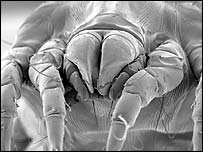Everything you need to know about house dust mites

the mighty mite
House dust mites are organisms that are only visible through a microscope and are present in every home, no matter how many times you dust! The cleanliness of your home has no bearing on the presence of house dust mites; they live in all homes, thriving in warm and humid conditions and on a diet of human skin. Beds are the natural breeding ground for these little critters, giving them a warm environment and a constant supply of your skin on which to snack.
This does seem horrific, but of course most of us are blissfully unaware of their presence, given their microscopic size. Or are we? Perhaps that allergy we’re putting down to hay fever or what we thought was adult-onset asthma is in fact due to a house dust mite allergy. While some of us can share our bed with the mites to no ill affect, many people have a reaction to the proteins present in the dust mites’ excretion. When the excretions are inhaled or touched, the allergy sufferer produces antibodies which in turn release a chemical called histamine. Histamine then causes swelling in the respiratory passages of the sufferer and can cause symptoms identical to those of hay fever and asthma. People who suffer from dermatitis and similar skin conditions can also find that house dust mites exacerbate their symptoms.
House dust mites are found in our beds all year round. Without treatment many sufferers will experience unpleasant symptoms without relief throughout the months, unlike seasonal hay fever sufferers. While the respiratory system bears the brunt of the allergy, sufferers can also experience symptoms such as a runny nose, blocked sinuses, sneezing, watering eyes and eczema-like skin conditions.
So what can we do to beat these critters? The most important thing is to restore your bed to a healthy environment, free from dust mites and allergens. While regularly Hoovering and flipping the mattress will help in the short-term, the only solution is to treat the mattress and linen in order to kill the dust mites and prevent them from setting up home in your bed. But it’s also vital that you do this without introducing harmful chemicals into your bed.
Our Neem Oil is entirely natural and is made by extracting oil from the seeds of the Neem tree. The Neem tree is indigenous to the Indian sub-continent and the seeds and other elements of the tree have been used for their advantageous medicinal properties for more than 4,500 years. In fact, in the first millennium BC the Neem tree was known locally as the “Sarva Roga Nivarini”, which translates as one that could cure all ailments and ills. Neem Oil is highly effective in protecting your mattress, pillows, duvets and bedlinen from dust mites for up to 2 years. You can buy the treatment in a 100ml spray for your home and we are also able to treat all mattresses, comforters, duvets and pillows purchased through us with Neem Oil while they are being made, giving the most comprehensive protection for over 2 years.
While it can’t eradicate the problem (the mites are quick off the mark and can colonise a mattress or duvet in only a few months), nor clear prior infestation (which calls for professional pest control), Neem Oil is one of the best natural ways to protect your precious bedroom environment from these persistent and pesky mites. And when ordering your next mattress (and frankly who doesn’t feel like having a new mattress after learning all there is to know about house dust mites!) then consider a natural latex mattress as the mites find the material a hostile environment.